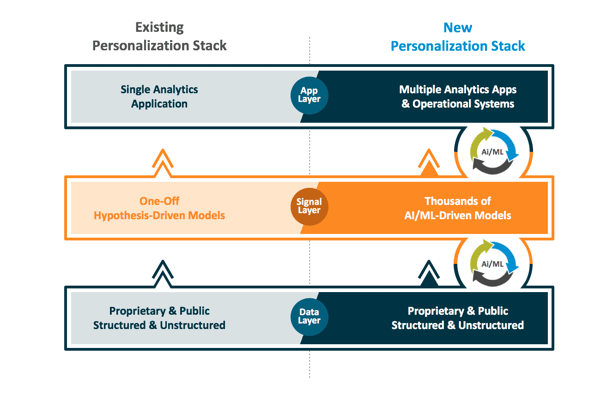AI-driven personalization holds a lot of promise for marketers. However, few have managed to put the promise into practice because the leap from data lab to real world production has been too great. A new approach is opening the possibility of making AI-driven insights a reality.
Why AI-Driven Personalization Projects Fail
In recent years, with the growth of processing power and new AI and machine learning tools for working with large data sets, data science has evolved. However, it still has not been able to keep up with the requirement of real time insights needed to drive modern personalization programs. What worked in theory in the lab failed under the pressure of the sheer scale of a production environment which had to account for thousands of attributes from many different sources.
The Case of the Cranky Wireless Carrier Customer
A national wireless carrier tasked its customer service team to upsell customers to larger data plans. This had the dual benefit of increasing the company’s predictable revenue and eliminating unplanned overage fees for customers. The intent was to improve customer satisfaction and thereby increase the likelihood of renewals and positive feedback. The problem was customers were learning of the data overages and fees after they received a bill. This lead to UN-happy customers, complaint calls and defections to competitors.
When customers called to complain they were already cranky and not open to offers to upgrade. This problem was exacerbated by a lack of access to real time information by customer service agents. Static historical data about usage was not enough to get the customer to change their plan or behavior.
To turn this situation around, wireless carriers are attempting to be more proactive. If a customer is watching more movies or consuming other high-bandwidth content, the time to tell them about a potential overage is before it happens. A few options could be offered:
- A new data plan showing lowered costs vs month to month overage fees.
- Dashboards to allow the customer to set their own limits on data usage.
- An alternative package that combines new devices and increased data limits.
All of these make sense and work great – in the lab where data sets are small and all information is accessible. To work in practice, the analytics engine must anticipate potential issues and proactively push solutions to the customer service rep. Or even better, send solutions directly to the customer before an invoice with overage fees is sent out.
Two Points of Potential Failure
The Lab-to-Production Chasm: The challenge with leaping from lab to production is more than a data size problem. There are other issues as well.
- Data modeling tools may not be compatible with systems used by marketing and customer service teams.
- Real time processing of massive raw data sources may degrade the performance of production systems.
- Any insights or recommendations must be delivered to service agents within the systems they are already using.
Algorithmic Echo Chambers: Another challenge centers on the very nature of behavioral listening analysis. Social media and search results tend to only give us more of what we’ve already viewed or purchased. This precludes the chance to learn or see something new which could be beneficial. AI/machine learning applications can incorporate “test offers” into the algorithmic mix and drive hidden growth potential.
Pathway to Personalization Production
A new “platform” approach is helping to alleviate the challenges associated with moving from the lab to production. Using AI and machine learning techniques the platform becomes a signal processing/orchestration layer (aka simply the “signal layer”) between the data and the end user systems. See diagram below. (click the image to view it larger)
In the new Personalization Stack, the signal layer is provided with greater horsepower using AI and machine learning. These technologies enable processing of large volumes of data, including real-time behaviors from websites, social media, or sensors as well as operational and transactional information. In addition, AI and machine learning also make it possible to sense when relevant insights are produced within models, and can translate them to actionable tasks within the operational systems used by customer-facing reps.
This approach helps to standardize and consolidate sources making them more readily available to an analytics workbench where algorithms are tuned and tested. The approach can also be used to package algorithms for export to production systems without loss of fidelity.
The Bottom Line
A platform approach automates the analytics-intensive signal layer using AI and machine learning, providing numerous benefits:
- It is an “always-on” resource that can be connected directly to the marketing, customer support and other outward-facing applications that drive user and customer experience.
- It also addresses the “algorithm echo chamber” problem by continuously enriching and testing profile-based algorithms with new data from “like” personas.
- It frees data scientists and business users to focus on the higher-level actions like planning and executing marketing strategies.
- Most importantly, your customer engagement programs get out of the lab and into the real world.
To learn more about the data architecture approaches that support a “personalization stack”, see the following additional content from Earley Information Science:
[Webinar] The Customer Data Platform – A Path to a Unified Customer Experience
[ITPro Article] The Problem With AI

